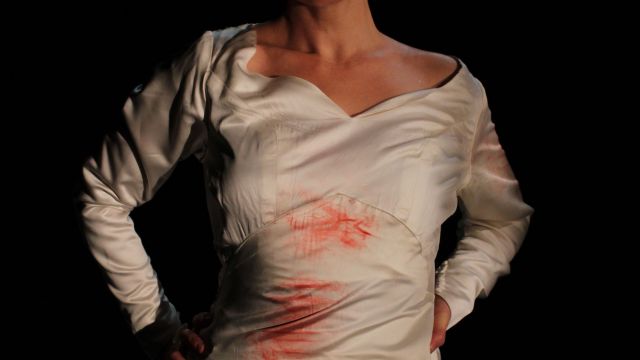Quick Death and Slow Love
Quick Death isn’t about Death and Slow Love is not about Love. Well, not exactly. This pair of clever one-act plays present images, catchphrases, and, yes, wittily chosen clichés that represent death and love, chiefly in cinema, but also in literature, and therefore, possibly, in our easily influenced imaginations. Much laughter springs from the audience’s recognition of these tropes – but the underlying intention is deadly serious. Richard Murphet is demonstrating for us how these representations, beguiling as they can be, hide or remove us from the realities of death and love.
Quick Death has a kind of framing device: off stage, the sound of a typewriter and a woman’s voice asking, ‘Are you all right in there?’ Ah-ha, we think. We are inside a writer’s fevered imagination. What follows is, if you like, a sort of pulp fiction, film noir montage, a juxtaposition of images achieved in extremely brief ‘scenes’ separated by blackouts at a rapid-fire, unrelenting pace. A loser (Kevin Kiernan-Molloy) called ‘Ray’ (the writer’s alter ego) is shot and dies – quickly – over and over again. There is a figure in a black Fedora and coat – the man with the gun (James Cook). There is the femme fatale (Emma Tufrey Smith), there is the romantic ‘bad girl’ (Naomi Rukavina) complete with some Lauren Bacall dialogue from To Have and Have Not. There is a suitcase filled with money. There is death after death. It is a nightmare. It is at several removes from the real or everyday deaths that occur on battlefields, in refugee camps, in famines or plagues or even in beds from old age – and how those deaths are experienced and understood.
It is striking how economical Mr Murphet can be in his choice of images and snatches of dialogue, and how instantaneously the audience gets them. Possibly the pleasures of recognition and comprehension may be less for younger folks or those who just don’t know these genres, but that’s their lookout. Mr Murphet is wonderfully aided by his cast – all of whom seem to get the concept completely, eschewing ‘psychology’ and representing oh-so-familiar stereotypes with great discipline and precision. This quartet, who play their stock characters absolutely straight (no winking at the audience), also invest an exhausting amount of energy, not just in repeatedly dying, but in the multiple resets needed for the flow of moments.
Slow Love has no framing device, but quickly we know exactly where we are – that is to say, in what genre. It’s the Love Triangle, a tale of infidelity and deceit. Naomi Rukavina, ‘Woman 1’, is clearly consumed with impatience for the arrival of… her husband? Or lover? To mix things up, we soon get a second Love Triangle. Yet again, the actors precisely represent the sine qua non of the Romance genre - the wife, her rival (Ms Tufry Smith), the stranger (Mr Kiernan-Molloy) and the baffled but still devious husband (Mr Cook) – without resort to psychology and with no more than shreds of the familiar situation.
Here too Jacob Battista’s design really comes into its own. In Quick Death, his diagonal division of the flats into contrasting colours suggests the high key shafts of light of Expressionism and its American offspring, Noir. In Slow Love, it’s the sundrenched adobe in gelato tones. And of course we must have Venetian blinds with their shadows. Now Steve Hendy drenches the stage with light – while there is light, since again there is blackout after blackout – a challenge absolutely met by the lights operator, Shane Thompson. Both pieces are overlaid with snatches of music – at times a comment on the action, at other times deliberately inappropriate.
Quick Death/Slow Love is witty and entertaining. The cast and the precision with which they are directed are a pleasure to watch. But this is also a show which could not exist without a great deal of erudition and thought on Mr Murphet’s part and the focussed collaboration of his cast and designers. And Mr Murphet is up-front about his sources: he lists them – text, images, music – in the programme. Like all the best comedy – because despite its originality of form, that’s what this is – the two pieces have a serious intent – it’s art that conceals art but also reveals artifice.
Michael Brindley
Subscribe to our E-Newsletter, buy our latest print edition or find a Performing Arts book at Book Nook.

